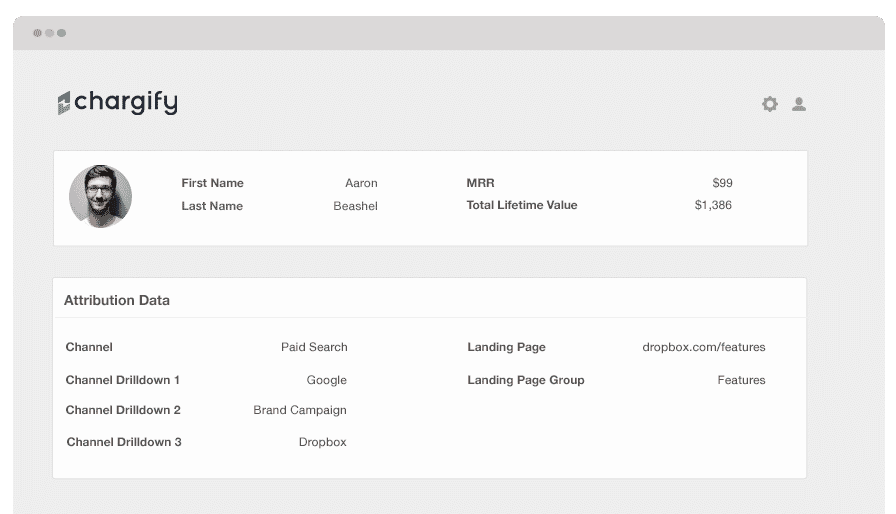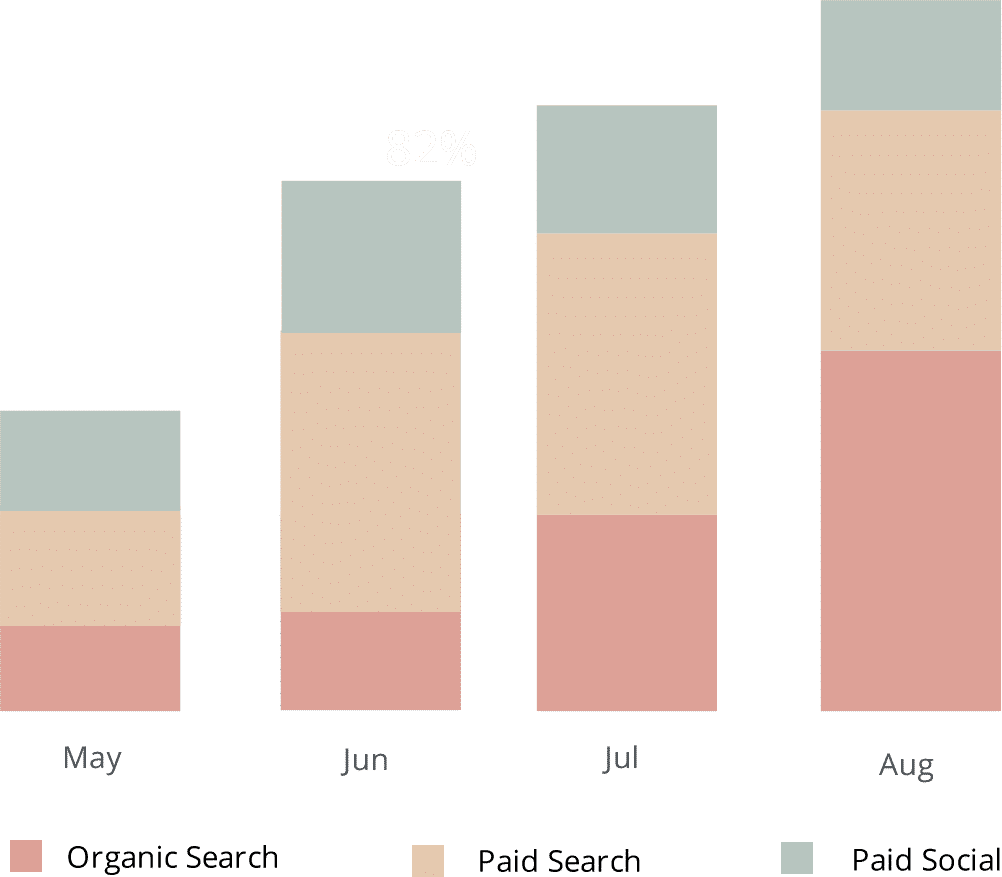How to send UTM parameters into Chargify
Learn how to send UTM parameters into Chargify so you can see what marketing channels & campaigns are generating your customers & revenue

Subscription metrics such as MRR, ARR, Churn, are great to give you an idea of how you're performing on a more holistic and macro level.
But, in order to really understand the success of your user acquisition and lead generation, you need more detailed data. You need the ability to break down these subscription metrics based on the marketing channel and campaign the user came from.
While Chargify is a great billing and customer management platform that lets you run reports that include metrics such as MRR, ARR and Churn, in order to see these metrics broken down by marketing channel or campaign, you need to somehow pass UTM parameters and other marketing channel data into it.
With Attributer, you can do just that. And in this article, we'll show you exactly how.
What is Attributer?
Attributer is a bit of code that you add to your website that looks at how the a visitor arrives at your site (including whether there were UTM parameters present in their initial URL).
From there, Attributer will categorise the visitor's visit into different marketing channels and campaigns. This includes Paid Search, Paid Social, Organic Search and more! This information will then be stored in your visitor's browser.
Then, when a user completes your signup form to register for your product yhis information will then be passed into Chargify, alongside that user's first name, last name, contact details and whatever other information you request in your signup form.
Finally, you can use this data to segment your revenue reports and understand what channels and campaigns are driving your customers & revenue.
4 steps for capturing UTM parameters in Chargify
You can easily get UTM parameters (as well as marketing attribution data for organic channels) into Chargify by following these 4 steps:
1. Add UTM parameters to your ads

To get going, you will need to add UTM parameters to all the paid ads & campaigns that you're currently running so that Attributer can track the marketing channel & campaign that your traffic is arriving onto your site from.
So, if you have paid ads and campaigns running on social media platforms or on bespoke campaigns with trade publications, all of these need to be updated with your UTM data!
2. Attributer stores the UTM parameters in a cookie

Once you have installed the Attributer code onto your website, it will automatically start monitoring for these UTM parameters in the URLs. When a visitor arrives from a link tagged with UTM parameters (I.e. from one of your ads), it can store this data in a cookie within your visitor's browser.
3. UTM parameters are sent to Chargify

Let's say a user arrives on your website and fills out your signup form to create an account in your application. The UTM parameters, alongside all the other information inputted by the user on your form (First Name, Last Name, Email, etc.) will then be passed along into Chargify.
This information can sent to Chargify in two different ways:
- Hidden fields in forms - Hidden fields can be added to your signup form and Attributer will automatically write the UTM parameters and other marketing attribution data to them. Once the user submits the form, this data is passed to Chargify alongside all the other information the user entered in the form (like their name, email, company, etc).
- Retrieved from the cookie - A simple line of javascript can be added to your signup form so that the UTM parameters are extracted from the Attributer cookie and then passed into Chargify. This is especially useful if your users have the option of signing up for your product with their Google or social media accounts (which removes the need for them to complete a form).
4. Run reports in Chargify

With the data flowing in, Chargify now has the UTM parameters (and other marketing channel attribution data) of each one of your customers.
With these additional bits of information, not only can you obtain the typical subscription information, such as Churn, ARR, and MRR, but you can break it down based on marketing channel and campaign.
More specifically, some of the metrics you'll now be equipped with include:
- New Trials added each month by Channel or Campaign
- Trial to Customer conversion rate by Channel or Campaign
- New Customers added each month by Channel or Campaign
- New MRR added each month by Channel or Campaign
- New ARR added each month by Channel or Campaign
- ARPU by Channel or Campaign
- Lifetime Value by Channel or Campaign
Customer Churn Rate by Channel or Campaign - MRR Churn Rate by Channel or Campaign
- And more!
Why using Attributer is better than capturing raw UTM parameters
While we understand that there are undoubtedly other UTM capturing tools out there on the market to help you pass UTM parameters into Chargify. Or that you can also ask a developer to help you install a code onto your site to achieve the same thing – Attributer offers you more. Much more.
This includes:
1. Captures all traffic
Even if UTM parameters aren't present in the URL of the website visitor (likely because they came from an organic channel like Organic Search or Organic Social), Attributer can still track how that user found you and pass that marketing data into Chargify.
This includes organic mediums, such as Organic Search, Referral, Direct and more! All of this can be tracked just as easily as paid ads.
2. Remembers the data across multiple page views and sessions
Most other UTM capturing software out there require that the UTM parameters are present on the page where the user signs up for your product, otherwise the information can't be passed with the marketing data into Chargify.
But with Attributer, this isn't the case.
This is important because for most SaaS businesses, you're not sending paid ads traffic directly to your signup page, you're sending it to a landing page. So if a user was to click on your ad, land on your landing page and then complete the form on your signup page the UTM parameters would be lost.
But with Attributer, we store the UTM parameters in a cookie in the user's browser, which means that this marketing information is never lost regardless of what page on your site the user completes your signup form.
3. Provides cleaner data
If you've worked with UTM parameters before, you'll know how messy it can get, especially if you've had different agencies, teams and individuals handling your account and campaigns.
Let's say you have a Facebook Ad tagged with UTM_Source=Facebook (capitalized), some others with UTM_Source=facebook (uncapitalized), and some with UTM_Source=fb. If you were trying to run reports in Chargify with other UTM parameter capturing tools, this would be treated as 3 separate channels, leaving you to have to manually stitch these together yourself.
Attributer understands how common it is for this to occur and therefore knows how to handle these irregularities. And so in the situation that something like the above were to occur, Attributer would still attribute all of the above visits to 'Paid Social'
4. Captures landing page data as well
Like most SaaS companies, you probably put a lot of time and energy into creating content for your site (like a blog for instance).
But the thing is if you're not measuring whether these pieces of content are helping you acquire new users, then you don't know whether these efforts are actually worthwhile.
Not only can Attributer capture UTM parameters and help you understand the performance of your ads, but it captures information like the landing page and landing page category, allowing you to see how well your content marketing efforts are performing.
Wrap up
If you're wanting to send UTM parameters and other marketing channel attribution data into Chargify, then Attributer is the tool for you!
Exceeding the functionalities of the standard UTM capturing tools out there on the market, Attributer can do so much more, such as clean up your UTM data, measure the success of your content as well as track users even if they didn't sign up for your product or service through paid means.
So, sign up today for a 14-day free trial to see what Attributer can do for your business.
Get Started For Free
Start your 14-day free trial of Attributer today!

About the Author
Aaron Beashel is the founder of Attributer and has over 15 years of experience in marketing & analytics. He is a recognized expert in the subject and has written articles for leading websites such as Hubspot, Zapier, Search Engine Journal, Buffer, Unbounce & more. Learn more about Aaron here.
